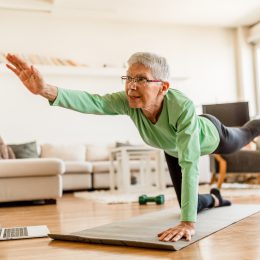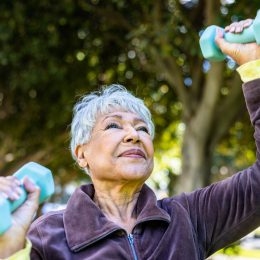The 10-Minute Solution for Stress and Muscle Pain
Relieve anxiety and tight muscles in your whole body with this simple relaxation technique.

Wouldn’t it be great if all it took to melt stress and muscle tension was a little sunshine and a fruity drink with a paper umbrella?
Yes, that definitely works sometimes. Unfortunately, other times it takes just a bit more effort to tame stress. What gives?
The body is smart, and its job is to protect you from danger. When you’re stressed, you activate your body’s natural fight-or-flight response. It deploys cortisol and other stress hormones. Your heart rate and breathing increase. Your muscles tense.
If you’re truly in danger, this response is a good thing. It helps you respond to or run away from a threat.
But if you’re not, and especially if you’re frequently stressed, this can lead to chronic inflammation, sleep disturbances, and digestive problems. It can also lead to aches and pains throughout your whole body: your temples, jaw, neck, shoulders, back, hips, legs, and even your hands and feet. Ouch!
Luckily, any stress management technique can help you tame chronic stress and the many symptoms that can come with it. But if you’re dealing with muscle tension, you may want to try one in particular: progressive muscle relaxation.
Get and stay fit with SilverSneakers! Choose from dozens of different Community classes, visit a participating fitness location, or view the current schedule of SilverSneakers LIVE online classes.
How Progressive Muscle Relaxation Works
Progressive muscle relaxation is a simple mind-body technique that involves tensing and then relaxing each muscle group in your body in sequence. You can start from your feet and work your way up, or you can start from your head and work your way down.
Either way, instead of trying to relax all of your muscles at once, you spend a few seconds on each group, letting your mind tell your body to relax and then allowing your body to sense that relaxation.
The goal is to trigger your body’s natural relaxation response, the counterpart to its stress response, according to the National Center for Complementary and Integrative Health (NCCIH). Like other relaxation techniques, it can relieve stress and help you sleep better.
A Treatment for Chronic Stress and Pain
Increasingly, you may see progressive muscle relaxation as a complementary or alternative therapy for anxiety, chronic pain, or other health conditions.
For example, it may be recommended for veterans or people in high-stress professions.
If you have chronic pain, your doctor may advise against opioids, which can cause dizziness and confusion in older adults. Instead, your doctor may prescribe a combination of physical therapy, relaxation techniques, and a different type of pain medication with a lower risk of side effects.
And for people undergoing chemotherapy, a combination of progressive muscle relaxation and medication can help treat nausea, according to the NCCIH.
Ready to Try It?
Progressive muscle relaxation is generally safe for healthy people. But as always, safety is key. The exercises here may be different or more advanced than those you’ll experience in a SilverSneakers class. If you have a chronic condition (including heart disease), an injury, or balance issues, talk to your doctor first.
You can perform progressive muscle relaxation in a sturdy, comfortable chair. Or you can lie on a mat or other supportive surface in resting pose (a.k.a. savasana or corpse pose). How to do it: Lie down with your legs straight. Rest your arms at your sides a few inches away from your body, palms facing up.
Subscribe to our newsletter
It's quick and easy. You could be one of the 13 million people who are eligible.
Already a member? Click to discover our 15,000+ participating locations.
Follow Us
From here, close your eyes, and breathe naturally. Begin a mental scan of your body. Start at your toes, and work up to your face. As you work your way up your body, notice how each area feels. Then, tense each area for up to five seconds, and relax the area for 10 seconds or longer. Feel those muscles relax before moving on to the next body part. Stop if you feel pain at any point.
Tense your toes for five seconds. Relax your toes for 10 seconds. How do they feel?
Now, tense your calves for five seconds. Relax your calves for 10 seconds. How do you they feel?
Continue with your thighs, glutes, belly, shoulders, arms, fingers, neck, and face. When you finish, relax for another five to 10 minutes, if you’d like.
When you’re ready to come out of the pose, slowly introduce movement back into your body by wiggling your toes and then your fingers. Open your eyes gently. Draw your knees in, roll to your side, and sit up slowly. Check that you feel steady before standing up.
Take Your Favorite SilverSneakers Classes Online!
SilverSneakers members can access live fitness classes and wellness workshops through SilverSneakers LIVE. See the latest schedule and RSVP for classes here.
Not a member? If you have a Medicare Plan, it may include SilverSneakers—at no additional cost. Check your eligibility instantly here.



